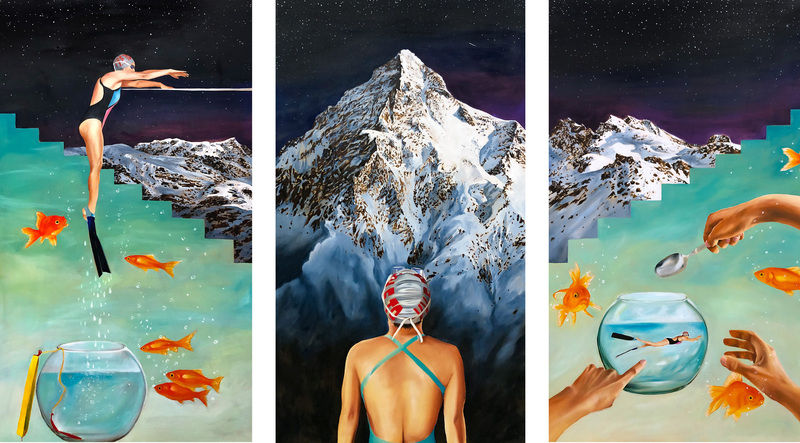"Through Other Eyes" interview with Stefano Zaratin
- Francesca Calzà
- Nov 18, 2024
- 4 min read
Francesca Calzà
Discover the talents of T.O.E. Art Market through a series of exclusive interviews with the artists on our platform.
Let us explore together the artistic practices and research carried out by the authors who enrich our community with their unique works. Each week, we invite you to learn more about the challenges, languages, themes and stories behind their work and get in touch with the creative minds that make T.O.E. Art Market a vibrant and dynamic showcase.
We are here in the company of Stefano Zaratin. Let's start right away with a few questions to get to know you better!
Francesca Calzà - Can you tell us a bit about your artistic journey? How did you get into art?
Stefano Zaratin - I have always loved drawing since my teenage years, and after I turned 20, I began attending various painting and graphic design courses. Over time, however, I realized that my true passion lay in the manipulation of materials, which led me to sculpture—whether working with wood, stone, or ceramics. Every exhibition I visited sparked new ideas. When I look back at the beginning of my journey, I see myself as a child experimenting with anything that came into my hands, and gradually, without even noticing, I found myself on a path that would lead me exactly where I was meant to go.

Francesca Calzà - What encounters, cultural references, or moments have had a strong impact on the development of your research?
Stefano Zaratin - My experience at the Sommerakademie in Salzburg was incredibly important. Immersing myself completely in art for several weeks changed the way I think. It’s like going to a foreign country to learn a new language—at first, you think in your native tongue, translate, and then express yourself. After a while, you realize that you no longer need that first step, and you start thinking directly in the new language. It’s an invaluable sensation. Moreover, my time at the Academy of Fine Arts was also crucial in helping me understand the world around me. I met professors who introduced me to a wide range of highly accomplished artists and, last but not least, made me question the why behind what I was doing—the reasons for choosing one material over another.
Francesca Calzà - Are there any constants in your work? What drives you to explore these themes?
Stefano Zaratin - Over the years, my work has focused on various themes, such as memory, or even specific objects—like the series I did on Venetian blinds. But for the past few years, I’ve been concentrating exclusively on environmental issues, a problem that should occupy everyone’s mind but is continuously pushed to an indefinite future and rarely confronted head-on. I enjoy imagining a dystopian future where nature adapts to seemingly impossible situations, and I must admit that my work often carries a certain degree of pessimism.
Francesca Calzà - How do your cultural roots and personal experiences influence your artistic practice? Can you provide any examples?
Stefano Zaratin - I have a scientific background (I studied industrial engineering and spent some years in electronic engineering at university). Although my work doesn't directly reflect those fields, I find that my general approach does. The attention to detail, the pursuit of order, the exploration of nature—sometimes I feel like a biologist—are all aspects that belong to the scientific world. I never intended to be an entomologist, but I often find myself studying insects, particularly those we typically avoid, like flies, driven by the desire to engage with what is typically considered “unappealing.”

Francesca Calzà - Can you share some details about your creative process?
Stefano Zaratin - I always start by sketching the work I have in mind. Sometimes, if it involves sculpting a part in wood, I also make clay models. I really enjoy the hands-on process, the "craftsmanship" aspect of it. Even when it comes to making molds in plaster or casting in lead, I always aim to be independent. I don’t seek perfection in these practices (despite my scientific background) because I enjoy being surprised by "chance." For example, I’m fascinated by how a positive shape changes after several pulls from the same mold, which inevitably deteriorates with use.
Francesca Calzà - How does a piece come to life? Do you always start with a predefined idea?
The inspiration often comes from a particular material—sometimes something that has been sitting in my studio for a while, simply waiting for time to "reveal" its potential—or from a new tool I’ve come across, like the 3D pen, which opened up new creative possibilities for me. Other times, the stimulus comes from a competition theme, which I always perceive as a personal challenge. Yet other times, it comes from a visited exhibition, perhaps of works far removed from my own, but that still manage to plant a seed that will eventually grow. During my 2024 residency, for instance, I collaborated with a textile company, so I researched the company, its materials (particularly cotton, which I had never worked with before), and the industrial process. It was an exciting experience. My works don’t always turn out exactly as I envisioned them. Sometimes they take slightly different paths, but that’s part of the beauty—allowing the work to grow on its own, "listening" to it without forcing our own "ego" onto it. This is a practice I think we should all embrace more often—whether in art, relationships, or creating a better environment.




Comments